The Montgomery County Quilt Trail was coordinated by UA County Extension Agent Amy Monk. She and a team of volunteers carefully chose their patterns, painted the blocks, and strategically placed the quilt blocks across their beautiful and rugged rural county. They wrote the stories that accompany the blocks. Encyclopedia of Arkansas notes that Montgomery County is known for its quartz crystal deposits, the rugged beauty of the Ouachita Mountains and its sparkling, clear waters. Every year, thousands enjoy hunting, hiking, observing nature, fishing, and participating in water sports on Lake Ouachita, Arkansas’s largest lake with 48,300 surface acres, and the Ouachita, Caddo, and Little Missouri rivers; the latter drops thirty-five feet per mile in its twenty-nine-mile journey through southern Montgomery County. Sites with houses, mounds, and cemeteries on the Caddo River at Caddo Gap and Norman, and those on the Little Missouri River, verify that Caddo Indians lived there in the thirteenth through fifteenth centuries, their society centering on farming and pottery making. We invite you to visit our picturesque county chock-full of interesting history and enjoy the Montgomery County Quilt Trail. A tip for traveling the trail: Due to lack of cell service in many areas, it is important to set your GPS while on the highway or in a service area. The GPS will continue to show the route even in dead areas.
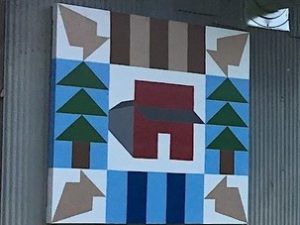
35 Vaught St.
Caddo Gap, AR
#18-1, Caddo Gap Mercantile, is at 35 Vaught St., Caddo Gap, AR. Owner Lynna McWilliams shares the story behind it. As a child I can remember many times going to visit my grandma and seeing her quilt frame hanging from the ceiling with her latest quilting project. It was usually lowered, so she could work on quilting whenever she had time as she went about her day. As I got older, I can remember helping to raise the quilt frame by wrapping the string or heavy twine of some sort from which it hung from the ceiling. I would wrap it around and around each corner until it was up and out of our way as we visited her home for Sunday dinner. Such a simple thing is now a special memory for me, because I have grown to love quilts and quilting and the story that each quilt shares from the person that makes it. My grandma made quilts for many people in her life, mostly for her children and grandchildren. Quilting was only one of her sewing pursuits, as a young widow, she had to begin to provide for her family at a rather young age after the death of my grandfather. She used her skill of sewing and worked for many years at a pajama factor. Later after her children were grown, I was privileged to be the recipient of two dutch doll quilts that she made that I used as a child and then later when I had my own children, put the same dutch doll quilts on their beds to be loved by them as well. What a special gift she had given to me, that I could share with the great-grandchildren that never met her here on earth. I began sewing myself at around the age of fourteen, my mother along with my grandmother helped me to learn this wonderful skill. To my regret, I didn’t lean much about quilting at the time. Even so, the love of sewing followed me through the years in sewing for my own children. It is only in the last few years that I have begun to learn this wonderful time-honored skill of quilting. My mother began her own journey into the quilting world when I was newly married. Since that time, she has made many quilts for her children and grandchildren. Now, when I have questions about quilting, I can ask her for advice as I begin each new project. The early memories of my grandmother’s sewing and quilting skills and my mother’s encouragement and advice have helped me to travel down the lovely road of sewing and I am so grateful to them for their influence in this area of my life. In trying to come up with a quilt block for our store at Gap Mercantile, we wanted to have a design that would reflect the historical influences of the area. We chose to make the center of our block the Mercantile building. It is a historical marker of the area. Many of the people who enter our doors everyday can attest to this as they have a story to tell about their experiences in this old community building. If only the walls of this building could talk! Oh, the stories they could certainly tell. We also wanted to include the Indian monument that we have here in our small community that was built in 1936, only four years after our Mercantile building was constructed in 1932. To symbolize the Indian monument, we chose to put arrowheads in each corner of our quilt block. We also included pine trees in our block, since they are a symbol of commerce in our area as a natural resource in the state of Arkansas. Not only does it provide income to our communities, but also adds beauty to our surroundings. Next, we chose to include the Swinging Bridge. Although it is no longer usable, you can still see the cables if you cross the bridge of the Caddo River across from the Mercantile. It was used for many years by the local children in order to get to school over the flood waters. To symbolize the bridge, we included brown rectangle blocks, across the top of the quilt block. Lastly, we chose to represent the beautiful Caddo River in our quilt block. People come to our area from all over the country to spend time floating and enjoying God’s handiwork in the Caddo River. The river is represented by the blue rectangle blocks across the bottom of the block. We certainly hope you enjoy seeing our block, but also learn a little of the history of our area. You can also visit our store and walkthrough history where we have quilts for sale as well as fabric. When you visit the Mercantile, you’ll enjoy a trip back through time where we’ll be glad to tell you more about the history of our beautiful area.
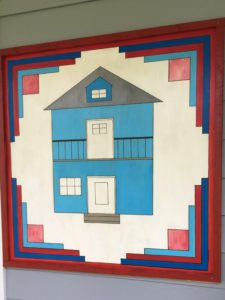
17 River St.
Caddo Gap AR
#18-2, Boarding House, is at 17 River St., Caddo Gap, AR. This quilt design is a modified “Log Cabin” quilt pattern with an applique replica of “The River Street Boarding House” in the center. It was designed by LaQuetta Klinge. The unincorporated town of Caddo Gap was developed from the Jim Vaught Plantation in the early 1900’s. Caddo Gap was a timber town and in 1907 the Gurdon and Fort Smith Railroad came to Montgomery County through Caddo Gap. The community added a newspaper, a bank, hotels, a cotton gin, blacksmith shop, a school, churches and a sawmill. The River Street Boarding House/Hotel at 17 River Street was built in 1908 to help accommodate this boom. Today this property is a private residence and has been lovingly restored by the current owners John and LaQuetta Klinge.

16 River St.
Caddo Gap AR
#18-3, Ava’s House, is at 16 River St., Caddo Gap, AR. This quilt block titled “Ava’s House” is in honor of my granddaughter Ava Clair. Ava is an unusual girl for a 17-year-old. She likes antiques, vintage quilts and all things from the 50’s, 60’s, 70’s and 80’s. Ava’s house was built in 1909 by Mrs. Susan Bassinger. The Bassingers were part of the original settlers of Caddo Gap. The small cottage was originally a three-room house and was built at the same time as the River Street Boarding House. The boarding house was owned and built by Mrs. Susan Sherfield. The cottage that sat next to the boarding house, however, was moved across the street and renovated in 2014. It now serves as the guest house of the current residents and owners of the boarding house.

16 River St.
Caddo Gap AR
#18-4, She Shed, is at 16 River St., Caddo Gap, AR. The owner, LaQuetta Klinge, shares the story: Hanging on my “She Shed” is a quilt block of a very old quilt pattern called “Twining Buds” which is an applique quilt, not a pieced quilt. The original of this quilt is very faded and tattered but still so lovely. It is one of my favorites from my quilt collection. This “She Shed” was built as a garage with a horse shed built on the back side probably in the 50’s. I have patched, painted and renovated with almost all used, recycled or gifted materials. I call it my “Little French Cottage”. It has no water or plumbing. But it is the perfect place for all of my thrift store, yard sale, auction, road side pick-up and dumpster dive treasures. It is a place for collecting and repurposing, a project center. It’s a place for daydreaming, reading or even napping. It’s my girl place, my “She Shed.”
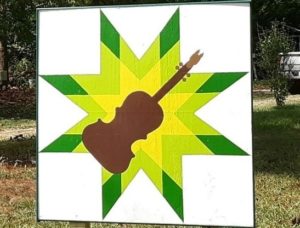
4142 Highway 240 W.
Caddo Gap AR
#18-5, Fiddler’s Star, is at 4142 Highway 240 West, Caddo Gap. Fiddles and fiddle music have always been a large part of Bea’s family tradition. When her grandpa moved to what later became Charleston Recreation area, Arkansas, he would sit on the front porch of their cabin and play his fiddle. The acoustics in the “holler” were good enough that his neighbors could hear the music and would often shout out a tune for him to play next. Her Mother, Violet Hemsley, learned to play the fiddle and made her first fiddle when she was 14 years old while living in the Alamo Community deep in the heart of the Ouachita Mountains. She has made at least 70 since that time including the fiddle pictured in the center of this quilt block which she made for Bea on Bea’s 50th birthday. The fiddle features a horsehead on the scroll because Ms. Bea has always loved them. Although Ms. Violet is now known as the Whittling Fiddle Lady of the Ozarks, she was born here in the Ouachita Mountains. Ms. Violet and Ms. Bea were both born in the same cabin in the Alamo Community of Montgomery County. Along with fiddle making, quilting was a favorite and needed pastime for early settlers. They made their own entertainment and sewed many of the items they needed to be cozy in their homes. Once a sheet, shirt, or dress was too worn to use, the good parts of it were recycled into quilts to keep the family warm or other items like potholders and baby doll clothes. Every little piece that could be reused for some other purpose was, or the family did without. The quilts were hand sewn and hand quilted, often filled with either cotton or feathers from their own farm used as batting. A sewing machine was a luxury many of the early settlers of this region could not afford. Ms. Bea is also an avid quilter with approximately 57 quilts made so far. Her favorite quilt block is the lone star block, and her favorite color combination is green and yellow. Her quilt block, called the Fiddler’s Star, combines both of her family traditions with the green and yellow lone star design quilt block featuring a fiddle applique as the centerpiece.
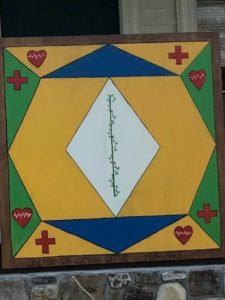
35 Vaught St.
Caddo Gap AR
#18-6, Country Doctor, is at 35 Vaught St., Caddo Gap. This quilt block is displayed on the original building that served as a doctor’s office from 1919 until 1943 on Vaught Street in the town of Caddo Gap, Arkansas. Dr. C.H. Luman used the little two-room office to treat patients. He also made house calls. He did not have a nurse or a receptionist. Ledgers in his handwriting list the date, name of the patient, treatment and the charge. This seems simple compared to the amount of paperwork we fill out in modern times. Traveling to a patient’s home to deliver a baby was a $20.00 fee. Dr. Luman always wrote in his ledger whether the baby was a boy or a girl. There was a $0.35 charge for medicine, a $0.25 charge for medicine for a child, and $0.50 to pull a tooth. One customer paid $3.00 on his bill by taking his team of mules to work on Dr. Luman’s farm for two days. There were no telephones, no computers, and no employees. Just a country doctor serving a rural community for 24 years. The medical symbol is in the center of the quilt block. Blue was chosen for depth and stability. It slows metabolism and produces a calming effect. Red is used because it can increase a person’s heart rate and make them feel energized. Yellow creates a warm and cheerful feeling and promotes muscle energy. Green was chosen because it promotes growth, harmony, and is the most restful color to the human eye. Brown was used in the quilt block because it is reassuring and comforting and stands for stability. The block in the center is white, which represents purity and cleanliness. White generally means all that is good and pure.

48 6th St.
Caddo Gap AR
#18-7, Onward Christian Soldiers, at Caddo Gap Baptist Church, 48 6th St., Caddo Gap, AR.Caddo Gap Baptist Church was established in 1905. Unfortunately, a fire destroyed the original building. The present building was erected in 1926 and continues as a place of worship. This quilt highlights the Christian Cross using the “Cross Roads” quilt pattern. Patchwork borders are anchored by the Christian flag on all four corners. Designed by LaQuetta Klinge, titled “Onward Christian Soldiers” in honor of the 115 years of continuous church service to the Caddo Gap Community.
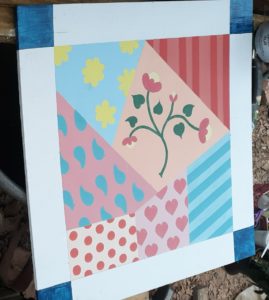
Caddo HIls & Buttermilk Springs
Caddo Gap AR
#18-8, Caddo Scrappy, is at Bethel Cemetery, which is at Caddo Hills Trail & Buttermilk Springs Road. Owner Dee Card describes her design. To honor the beautiful and practical scrappy quilts hand sewn by women of all social stations along the Caddo River, I have chosen the scrappy pattern as my quilt block. A true Scrappy quilt does not have a formal pattern and no two are identical. In a lot of ways, they are the scrapbook of the lives of the women and, sometimes the men, who made them. They were made from dresses worn to school, the dress they wore when their future husband came courting, the dress shirt their husband wore to their wedding and to church on Sunday. The skirts and shirts their children outgrew or wore out before they left home to start their own families. The baby clothes, the pieces of cloth gifted from visiting relatives. If the harvest had been good, the cloth bought from the local mercantile for clothing that also had any scraps sewn together for the quilt and the clothing itself later also used. Photos were rare and expensive during that time. Most families depended on locks of hair, jewelry and quilts to keep the memory of their loved ones close. It was a time when the ability to hand sew was not only a much needed ability it was an art that the ladies took great pride in. Quilts were hand sewn and hand tied or quilted depending on the makers time and resources. Some were also embroidered adding extra beauty and showing off the maker’s skills. Sewing the scraps together filled long winter hours and kept hands busy when the husbands were away hunting or at war. They were gifted to new brides, comforted babies, children with fever and wives who were now widows. This valley has been inhabited for thousands of years. First by the Native peoples who, in their own way, by stitching new items out of their old leather items practiced this tradition. Then European settlers arrived, also practicing this same skill and tradition. Today the current inhabitants of this Ouachita Mountain valley continue this tradition as a source of pride and heritage. This quilt block is placed at the Bethel Cemetery in Caddo Gap as a reminder that the Native Americans and those who now rest beneath the headstones once filled this valley along the Caddo River with love, laughter and life.
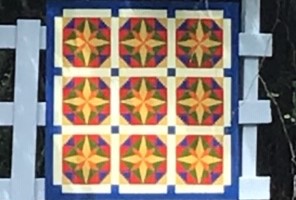
2018 Liberty Rd.
Norman AR
#18-9, Wild Flowers, is at the Holt Home at 2018 Liberty Road, Norman. Note that this location is about eight miles from the highway. This quilt block design was inspired by the wildflowers that grow along Liberty Road near Norman, Arkansas. Take a slow ride or hike down the ten miles of Liberty Road almost any time of the year and you will see wildflowers of all kinds. Early in the Spring before leaves appear on the trees escaped from cultivation a century ago, as well as the native farkleberry and serviceberry. Later the dogwood’s white blooms will sparkle among the early light green leaves. Look along the streams to spot the umbrella magnolia blooms centered in two-foot-long leaves at the end of a 20-foot-tall bare trunk, and keep your eyes peeled for the very rare white violet. Yellow flowers fill the fields with butter cups and dandelion blooms, and all types of sunflowers, including black-eyed susans. Partridge peas appear in wooded areas, and if you are lucky you may discover a yellow violet patch near the creek. Coreopsis and sunflowers carry on the yellow theme in the summer and the stately goldenrod demands attention in the fall. Blue and purple shades are a little harder to spot, but look for morning glory vines, lobelias, larkspur, tiny bluets in early spring, and of course, the violets. Purple ones in shaded moist areas and the blue dogtooth or bird-foot violets along the road shoulders. Trumpet vines produce clusters of four-inch orange flowers in late summer, and look up for their shy cousins, the crossvines, spotted yellow. Orange butterfly bush flowers stand out in a crowd. True red flowers are rarer, but along a little stream you may discover a stem or cardinal flowers, or look up to see native red honeysuckle vine high in the trees. Red clover has taken over some fields. Pink flowers are more common, and you may see large cone flowers or tiny fleabanes or asters, and patches of pink primroses in the spring, as well as a pink morning glory if get up early. Many of the flowers and trees found in Arkansas are not native but are invasive species that have made their homes in our state because of the mild climate. Privet hedge with its clusters of sweet-smelling white flowers has taken over many spots, especially along roads or in other open areas where it finds an opportunity. The white and cream-colored honeysuckle growing wild here is not native, neither is the mimosa tree with its delicate pink blooms. Occasionally you will find a yellow flower on a blooming cactus, another non-native plant that has moved in. These invaders present a problem to look at as we drive by. They provide food and shelter for a wide variety of insects that help to produce our food and fiber. Use of chemicals in farming, lack of places to grow on commercial size farms, and highway roadside maintenance that mows them down before they can produce seed, are all practices that work against wildflower growth. When you see wildflowers as you go down Liberty Road, appreciate their beauty and variety but also think of their unique role to play in the large scheme of the natural world.
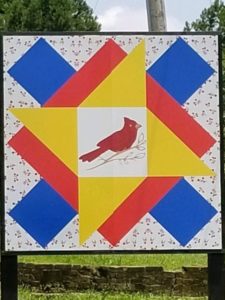
236 Hattie St.
Norman AR
#18-10, Star Squared Cardinal is at 236 Hattie St., Norman, AR. The 8’ x 8’ Star Squared quilt block is located adjacent to the Old Norman High School. The building is listed on the National Register of Historic Places. It is owned by a 501c3 organization, Norman Historic Preservation Program, Inc. Built in 1924 by Presbyterians and other citizens of Norman, the 2-story native stone structure, Caddo Valley Academy (CVA), aka Old Norman High School, was the only accredited high school in Montgomery County until 1930. Other schools in the Ouachita Mountains educated through 8th grade. The Presbyterian CVA offered room and board to students at the nearby Hillside Boarding House. Students from other areas chose to attend to get a good education led by excellent teachers from out of state. In 1930 the State of Arkansas was forced to educate students through 12th grade; with the payment of one dollar, the academy became the Norman High School (NHS) with the stipulation that Bible be offered as a subject. The boarding house evolved into Caddo Valley Academy Orphanage (still called CVA). In 1962 CVA closed and the district lost 65 students. Nine years later Norman and Caddo Gap merged, creating Caddo Hills School District. Both schools used the Norman High buildings the next year (1971-72) while the new school was built. The next 30+ years the Norman High structure changed ownership several times, none providing maintenance. When an organization made up of former students finally convinced the then owner to sell, the roof had gaping holes and much of the second floor was unsafe to be in. Alumni were generous with time, muscle, and money as they renovated the building. Today the Old Norman High School serves as a museum and community center, even as renovations continue. The building now is ADA accessible; a sloping auditorium floor and a stage allows for all types of programs and entertainment. The museum rooms include a one-room school, shotgun house furnishings, and lumber/farming displays. Free tours are given from 10-4 on Tuesdays and Fridays. The nine patch Star Squared Block tells the story of two small school districts consolidating. The red and white colors and the cardinal emblem represented the Norman district. The blue and gold were Caddo Gap district’s colors. The color blue also symbolizes the nearby Caddo River, wisdom and freedom. The tiny red heart branches on a white background and the Friendship Star indicate the love the two districts shared even before consolidation – making this transition easy. Beginning in 1964, Caddo Gap students came to the Norman campus to take agriculture and home economics, helping each district stay solvent. Jean Lybrand pieced the block, Tiffany Cox embroidered the cardinal and Mary Beth Lysobey wrote the narrative.
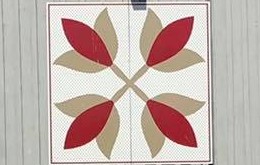
819 Luzerne St.
Mount Ida, AR
#18-11, Four Tulips, is TEMPORARILY UNAVAILABLE DUE TO REPAIRS. IT IS EXPECTED TO BE BACK UP IN TIME FOR THE OCTOBER 2024 SORGHUM FESTIVAL. It’s located at Heritage House Museum Barn at 819 Luzerne St., Mount Ida, AR. Betty Wheelers shares the story: This quilt was made by my great-grandmother, Sarah Standridge Wheeler. She and several of her older daughters made quilts by this pattern at the same time. My grandmother, Ada Wheeler Widener, was one of those daughters. These quilts were made prior to my grandmother’s marriage in 1900. My grandmothers quilt was lost in a house fire in 1925 when my mother, Viola Widener Payte, was 5 years old. Granny Wheeler’s quilt went to her youngest daughter, Rosie Wheeler, at her death. Later she gave Granny’s quilt to my grandmother. My grandmother has been gone for over 40 years and Granny’s quilt has belonged to my youngest aunt, Aunt Alice Widener. Aunt Alice felt it belonged in a museum. So, when she heard we would soon have a museum here; she was pleased to send it home to us. We agreed to see it turned over to Heritage House along with its history. The cloth from which it was pieced came from the carefully saved remnants of cloth used to make the clothing various family members wore. The cotton batting was cotton raised here on the Wheeler Homestead. The seeds would have been picked out by hand and the cotton carefully smoothed out on tightly stretched quilt lining until it was completely covered. Then the top would be carefully placed over the batting and basted into place. A “reach” would be quilted along the edges of the quilt. (A “reach” was the distance one could reach to make the quilting stitches.) The large quilt frames would be hung by cords from the ceiling. When the room was needed for some other activity, the cords would be wrapped around and around the end of the cars until it was above head height. For a quilt with smaller pieces, the cotton would have been carefully carded to comb the fiber smoother and flatter than was possible to do by hand alone. The quilt was donated by Alice Widener and Viola Widener Payte. The history was compiled by Betty Wheeler.
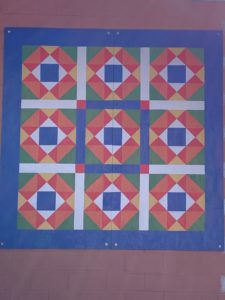
135 S. West St.
Mount Ida AR
#18-12, Ouachita Bear Paw, is at 135 S. West St., Mount Ida, AR. The block is on the side of the art gallery and actually faces S. George Street. The Ouachita Artists named their quilt design “The Ouachita Bear Paw” pattern. Arkansas was initially known as the Bear State, pronounced the “Bar” State. In 1858-1923, pre settlement estimates of up to 50,000 bears roamed the mostly wooded wilderness. In the early part of the last century, bears were hunted out until there were only about 50 left in the state, in the swampy areas of SE Arkansas. New bears were reintroduced in 1958 by the Arkansas Game and Fish Commission. Now their numbers are around 3,000 strong. It is no longer uncommon to find black bears roaming in the Ouachita National Forest lands or anywhere in Montgomery County, leaving their paw prints to show they were there. The strong, vivid colors in the quilt might be found on an artist’s palette and are taken from Ouachita Artists’ logo. These colors are also found in nature all around the county. The dominant blue represents the clear sky reflected in Lake Ouachita and calls to mind the rivers and streams found in abundance. The green is representative of the shortleaf pines native to this area and the many other species of trees in the forest. The bright red, yellow, orange and white accents recall the wide variety of flowering fruit trees and wildflowers that bloom throughout the year, as well as the brilliant color spectrum that appears in the woods during the fall season. Ouachita Artists, founded in 2011, is a group of Montgomery County residents and adjacent counties who have in common the support of local arts and crafts and those who create them. In addition to offering their work for the public’s view, they provide a venue for sales that ordinarily would not be available to individuals. The group conducts numerous educational events throughout the year: classes, workshops, monthly programs, and opportunities for children to be introduced to art and craft basics. Ouachita Artists participates in the community by providing classes to people in the assisted living program, supporting 4-H Clubs, and providing locals with leisure activities. Ouachita Artists has been named a “Friend of 4-H,” and was recognized by the Chamber of Commerce as a winner in their annual awards. Ouachita Artists is a non-profit organization run by volunteers.
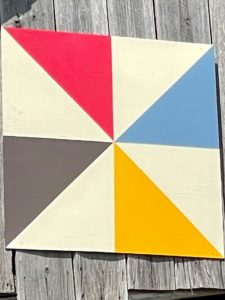
1041 Southfork Rd.
Mount Ida AR
#18-13, Pinwheel, hangs on the Gaston barn which will be about 500 feet before arriving at 1041 Southfork Rd., Mount Ida, AR. The pinwheel quilt block tells the story of this farm’s past. The brown spoke of this pinwheel represents the original 80-acre farm ground which was homesteaded in 1860 by Frederick Salyers. The red spoke represents the barn which was added to the property in the early 1900’s. John A. Watkins had purchased the property in the 1890’s and then passed to William Watkins. The loft of the barn was used to store square bales before round bales were popularized. Where the door is located was a feed room which is now used to hold orphaned calves who need extra attention and protection from coyotes. The maize spoke represents the farmhouse, which was built around 1938 by the next owner, Alvie Scott, who had purchased the property in 1931. By this time the property had expanded to 120 acres. The blue spoke represents the Charles Bates family who purchased the property in 1975. His daughter Becky, and husband Ed Gaston, remodeled the farmhouse. Charles retired from farming in the late 1990’s and Becky and Ed purchased his cattle and took over the farm. Becky and Ed still farm and live here today.
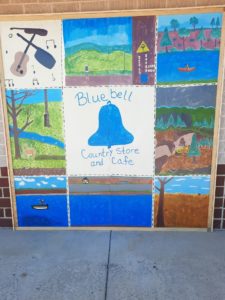
8 Hwy 298 East
Story AR
#18-14, “Story” of Tourism, 8 Highway 298 East, Story, AR. It’s at the intersection of Hwy 298 E and Hwy 27. This beautiful block on the side of the Blue Bell Café highlights eight opportunities for tourism near Story, Arkansas. This traditional, rural community was founded prior to the Civil War. Native Americans once survived here by hunting in the area. Story has had several schools, but they are all come and gone. Surrounded by the Ouachita National Forest and with Lake Ouachita just three miles away, the area offers outdoor adventures represented on this quilt block.
Fishing – Lake Ouachita is the largest manmade lake in Arkansas and has excellent bass and crappie fishing, several fishing tournaments have become popular for anglers.
Hunting – Once a survival skill, Story is known as a premiere site for both deer and turkey hunting.
Hiking – One of the longest hiking trails in the US, the Ouachita Trail, has 2 nearby trail heads, 27 North & 298 East. The Blue Bell shuttles hikers all along the trail from Pinnacle to Talihina, Oklahoma. Story is right in the middle of the trail, making it an ideal location for hikers to come off the trail, stay, and enjoy a meal at the Blue Bell Cafe.
Kayaking – Ouachita Kayaking provides guide service kayaking tours on the Ouachita River and Lake Ouachita.
Digging Crystals – The Sweet Surrender Crystal Mine is a fun way to enjoy the area’s unique geology.
Live Jam Sessions – Every Saturday night people enjoy live jam sessions of country, gospel, and bluegrass music, also represented on the quilt block.
Artisanship – Several Story residents are accomplished artisans highlighted at the Ouachita Artists Gallery in Mount Ida. A local potter sells her wares in the Blue Bell store and welcomes visitors to her pottery shop right here in Story.
Lodging – Story has become a growing tourist attraction with several properties for rent, as well as lodging available at the Fishing Village, RV sites, and campgrounds.
If you’re looking to get away from it all, Story is an ideal location for outdoor adventures without the distractions of modern life.
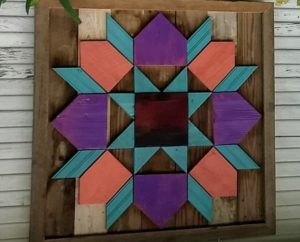
635 Whitetown Rd.
Oden AR
#18-15, Swoon, is on the Breitenbach Root Cellar at 635 Whitetown Rd., Oden, AR. It is easiest seen by driving just past the house. This Swoon block was made by Cathy and Dave Breitenbach from old barn wood found in the barn, and wood scraps left from remodeling the farmhouse home. It now hangs on the Root Cellar that was built in 1916. The back side of this building was a large vegetable garden with a grapevine trellis kept years ago. A huge Pecan tree stands in the background. The previous owner, Mrs. Polly Williams was also a quilter. Her old frame is still stored in the rafters in the topside of the Root Cellar. We keep a much smaller vegetable garden since moving here in 2015. The old dairy barn, well, and smoke house still stand on the property which is surrounded by farmland with grazing cattle. Cathy has enjoyed making quilts for over 30 years. Most of her quilts go to family members and friends, though she does have quite a few in her personal collection. The Swoon is one of Cathy’s favorite quilts as it has several variations. Of course, just changing up the fabrics makes a dramatic difference. There is room for parking in the driveway. The Root Cellar is on the right side and visitors are welcome to walk around the yard.
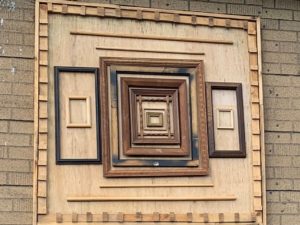
4562 Highway 88
Pine Ridge AR
#18-16, Log Cabin Windows, is at Lum and Abner Store, at
4562 Highway 88, Pine Ridge, AR. Visit the “Log Cabin Windows” at the Jot-Em-Down Store and Museum located on the corner of “Hole in the Ground Road” and Arkansas Hwy 88, twenty miles west of Mena and 20 miles east of Mt. Ida. The block was constructed using picture frames attached to the wooden background. The frame shapes indicate the fireplace below, just as they do with quilt fabric. Log cabin blocks have been iconic for many years, but picture frames make this one unique. Every picture frame is part of the cabin, including the windows. Today’s Pine Ridge quilting bee continues to make quilts in 2021. In the 1800s, many settlers chose home sites and built their real log cabins. I picture families working on their land all day, and at sunset, gazing through a window to plan their future. The land around Pine Ridge today is still heavily wooded. As the community grew, families rode their farm wagons down Hole in the Ground Road, crossing a high mountain creek that had come up out of a hole in the ground. New stores were ‘board and batten,’ not log cabins, and were near the dirt highway. Dick Huddleston’s store had been built in 1909, A.A. McKinzies’ store in 1904, and a new post office in 1902. The farmers’ own goods were bartered for goods they needed. Women used their extra eggs, worth one penny, to buy 2 ½ penny stamps to send letters to family and friends back home. The men carried whatever they had, or their own time, to get whatever they needed. For any of the store owners to purchase new goods, they had to take their farm wagons over the ‘Seven Devils’ (steep hills) on the way to Mena, AR. It took two teams and wagons to re-cross the hills after the wagons had been filled. The Goff warehouse was the most used. In the 1905’s and 20’s Chester (Lum) Lauck and Norris (Tuffy) Goff became the class-clowns in Mena schools and anywhere they were invited. The teachers knew to not turn their backs and the preachers knew they would hear a new version of their sermon on the street corner. They spent more time swapping gossip with storekeepers than taking orders for their fathers. However, they graduated from college and expected to work in Mena. The first real radio program was in Hot Spring, AR for a charity statewide talent event. By 1930, they had become radio professionals in Chicago, IL. The Hot Springs KTHS radio station had taken Chet and Tuffy to Chicago where they immediately, after a brief audition, hired to be a summer substitute. By the end of the summer, Lum and Abner had more listeners than the original program. They had picked the names of Lum Eddards and Abner Peabody for their own characters, and any other characters were based on people in the nearby Montgomery County communities. Chet (Lum) was Grand-pappy Spears and Cedric Wehunt. Tuff (Abner) was Squire Skimp, Mousey Grey, Dick Huddleston and others. Dick was a good businessman and promoted Lum and Abner as they promoted him and Pine Ridge. The very entertaining radio programs relieved much stress during the Dust Bowl, Great Depression and WWII. The government asked that every radio broadcast include short announcements about the war efforts. Lum and Abner spend the entire programs, not just a few seconds, creating a Pine Ridge version. Every broadcast was delivered live and Chet and Tuffy had to remember several character voices. When they got confused, they just kept on talking. Distant “Lum and Abner” fans often drove all the way to Pine Ridge only to find what was still called Waters. Henry M. Waters had obtained a post office license in 1886 but didn’t stay long. The community building near his home was a church on Sunday and a one room schoolhouse during the weekdays. The cemetery was on the same grounds as the church/school and the first burial was a child in 1886. When she was ill, she had asked that the cemetery be placed near the school. More that 500 graves are well kept today. School lasted only a few months a year because children were needed for farming every season and helping with babies any time. After the McKinzie store closed in 1942 and Dick Huddleston died in 1963, the buildings were sold and became the “Lum and Abner Jot’em down Store’ and the “Lum and Abner Museum’ in 1970. Chet Lauck aided in the development of the museum which has held thousands of artifacts over the last 50 years, including everything from log cabin tools to Hollywood movies. We provide museum tours indoors and out. The gift shop handles many souvenirs and collectables reminiscent of earlier times. Lum and Abner put both Mena and Pine Ridge on the map.

15 Vault St.
Caddo Gap AR
#18-17, is located at 15 Vault St., Caddo Gap, AR on the Old Caddo Gap Bank. This quilt, “Mama’s Flower Garden,” is made and displayed in honor of my mother, Marcella Rutherford. The quilt is patterned after the very old quilt pattern, “Grandmother’s Flower Garden.” It is colored in shades of pink to reflect my mom’s love of any and all things pink; including home interiors, clothing, flowers, and quilts. Mom developed a love of quilts as a young girl and carried that passion throughout her life. As an avid quilt collector and antique dealer, she bought and sold thousands of quilts and antiques through her many successful business ventures which included Marcella’s Antiques, Blizzard of Quilts, a quilt show vendor at the Houston Texas Quilt Show, Rutherford Auction Barn, and in later years as an eBay seller known as “Textile Annie,” selling over 10,000 quilts! After her final retirement, she returned to Montgomery County where she had grown up. As her final endeavor, she bought and restored the old rock bank building in Caddo Gap. Mother turned the old bank building into her personal residence and enjoyed living here until her passing in 2020. The Caddo Gap Bank was originally built in the early 1900’s but unfortunately was destroyed by a fire. The bank was rebuilt with stone in 1929.

1090 HIghway 88 W.
Oden AR
#18-18, Double T, is at 1090 Highway 88 West, Oden, AR. It was created by Dave & Cathy Breitenbach of Oden for Big T’s General Store. The Double T quilt block can be found hanging on the front porch of the old stone Oden Bank building at Big T’s General Store. Big T’s is locally owned and operated by Tommy Beshears. This 48 inch quilt square is made from old barn wood boards cut into 24 triangles and 4 squares making up the four T’s. These wood blocks are attached to a plywood backboard with a barn wood frame added for extra durability. The T blocks are painted orange and black to incorporate the strong community ties to the Oden School Timberwolves. The community of Oden dates back to 1849. In the early 20th Century, Oden was a thriving town with a hotel, a bank, several merchant stores, and a service station. The old Oden Bank, now connected to Big T’s still stands from that time period and now displays the Double T Quilt Block. Please come by and visit. You will find friendly folks, many who will tell you a thing or two about our community. Big T’s has a variety of general merchandise and great tasting BBQ. It’s the place to be on a warm weather day for a soft serve ice cream cone!
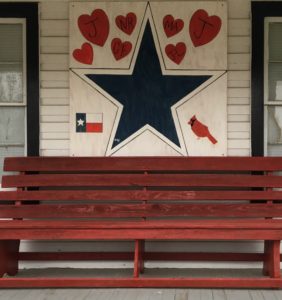
235 Twin Bridges Rd.
Glenwood AR
#18-19, My Heart Strings, is at 235 Twin Bridges Rd., Glenwood, AR. Owner Melody Jones shares the story. “My quilt block represents all the things that I love and hold dear to my heart. The blue star represents the Dallas Cowboys, the number was my favorite player’s. Some people might find this silly but watching them play was something that my dad and I did together since I was 8 years old. I was born and raised in Texas. My late grandmother and mother loved redbirds. The larger red hearts have the initials of my two daughters. The smaller hearts have the initials of my grandchildren. The blank heart is for the grand that will be here this summer.”

1905 Hwy 70 E.
Glenwood AR
#18-20, The Old Bright Barn, at 1905 Highway 70 E., Glenwood, is in the Caney Township of Montgomery County, in the Mt Tabor community. Our great grandfather, James Dozier (J.D.) Bright, bought the log barn in Hot Springs County in 1944. He marked each log as he took it down so that he could rebuild it to its original state. He was a little man with a little barn, although he may have been short in stature; he sure made up for it in heart. When he bought the property, it was 30 acres but later he donated a small portion of it to the Mt Tabor Cemetery that’s referred to as the old part of the cemetery and is where our grandparents are laid to rest. J.D. was a carpenter and beekeeper by trade. They raised what they ate from cattle to carrots. He also built their new home for our great grandmother, Carrie Elmira Buck Bright. Originally there was an old house on the site that was used for many years but in the early 1960’s the house was torn down. Our great grandparents were both caring, gentle people who adored their family. The quilt block is called a “Double Wedding Ring” and is “double” special because our great grandmother Carrie Bright pieced the quilt top in 1945 and her only daughter, our granny, Della Bright Jester quilted it in 1987. Della and her husband Samuel Jester inherited the property and raised their four daughters there. The Jesters definitely left their mark on this community and our hearts and the place is still known as “Samuel and Della’s place” today. Granny Jester (Della) was taught to quilt by her mother as a child. Della didn’t have a lazy bone in her body and was an immaculate housekeeper and kept both her home and table “company ready” because you never knew who would be stopping in to see grandpa. She was full of life and loved to make a big garden. She did her own tilling, planting, and weeding. She took pride in keeping her garden pristine until she passed away in 1990. Grandpa Jester (Samuel) bought, sold, and hauled timber for a living and was a “horse and gun trader” as a hobby. People came from all over to make a deal with him. We always knew not to get very attached to an animal because it might belong to someone else the next day. They, like our great grandparents, are buried in the family plot in the old part of Mt Tabor Cemetery. They are still missed, loved, and talked about today. When Della passed away her third daughter, Linda Jester, bought her two sister’s portions. Linda is very involved in our community. It’s been a running joke that she’s the “mayor” but in reality, she is our districts Justice of the Peace and she serves us well. There have been seven generations descending from the Brights on Della’s direct line of the family thus far. We are very proud to call this beautiful place home. There have been many wonderful memories made and shared here and it will be an honor for it to remain in our family for generations to come.
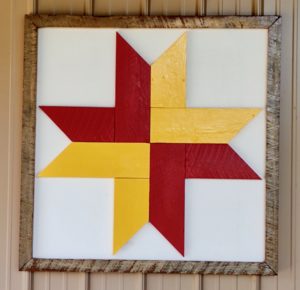
14020 Brushy Rd.
Oden AR
#18-21, Fellowship Star, is at 1402 Brushy Road, Oden, AR. It was created by Dave and Cathy Breitenbach of Oden for Brushy Creek Missionary Baptist Church. The 40 inch block can be found hanging on the Fellowship Hall. The location is 2.8 miles north of Highway 88 in Oden. Brushy Creek Missionary Baptist Church was organized May 24, 1873. There have been three church buildings at this location. The present building was built in 1940. The cemetery beside the church dates back to 1880. The adjacent Fellowship Hall is a recent addition built in 2019. Church members and visitors can frequently be found sharing a Sunday meal and fellowship after services in the Fellowship Hall. All are welcome to visit out little church. Service on Sunday begins at 11am with Pastor Tommy Beshears.
How exciting. Cannot wait to take this trail. So glad Ouachita Artists Gallery and Studio is on this trail.